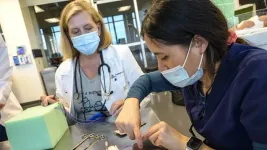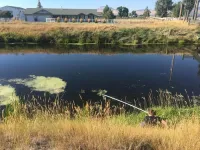The overall winning image depicts bright orange fruiting bodies growing on deadwood in the Australian rainforest and was taken by Cornelia Sattler from Macquarie University, Australia. The orange pore fungus was first observed in Madagascar but is now found throughout the world. Previous research has reported that invasive species, such as the European rabbit, root rot fungus and feral pigs, threaten 82% of Australian species at risk of extinction. As a result, Australia has particularly strict rules about bringing plants, animals, and organic matter into the country.
Cornelia Sattler said: “Despite its innocent and beautiful appearance, the orange pore fungus is an invasive species that displaces other fungi and is spreading throughout the Australian rainforest. It is important to closely monitor this fungus, whose spores are often transported by humans, in order to safeguard the biodiversity of Australia.”
Senior Editorial Board Member Arne Traulsen recommended the entry, saying: “Cornelia Sattler’s image allows us to peek into the world of fungi, organisms that are fascinating and yet underappreciated and understudied.”
In addition to the winning image, the judges also selected winners and runner ups in four categories: Research in Action, Protecting our Planet, Plants and Fungi, and Palaeoecology. All images are available on the Springer Nature press site.
Victor Huertas from James Cook University, Australia took the winning image for the Research in Action category. The photograph depicts the deployment of an underwater remotely operated vehicle at Coral Sea Marine Park, Australia. The device is used to survey oceans at depths that are beyond the reach of divers and has been used to discover new species in reefs and expand the known geographic range of multiple fish species.
Senior Editorial Board Member Luke Jacobus said: “This photograph captures the essence of ecological study. It showcases sharp imaging and good storytelling and invites us to be curious about our dynamic world.”
The Protecting our Planet category winner was captured by Roberto García-Roa from the University of Lund, Sweden, and features a sustainable beekeeping project launched by the Chimpanzee Conservation Center in Guinea. The aims to combat deforestation by encouraging locals to cultivate their own honey. A portion of the profits generated by the project go towards chimpanzee conservation activities.
Senior Editorial Board Member Josef Settele said: “This photo shows how very different aspects of wildlife conservation can be combined into win-win situation that helps simultaneously protect our planet and empower local communities.”
The Plants and Fungi category winner depicts a fungus parasitising the fruiting body of a zombie-ant fungus — a fungus that can compel infected ants to migrate to locations that are more favourable for its growth — and was taken by João Araújo from the New York Botanical Garden, New York, USA.
João Araújo said: “Zombie-ant fungi are found in forests all over the world, however the forests they inhabit are also shared with fungi that can parasitise, consume and even castrate them. Scientists have only recently started to catalogue and describe these fascinating fungi that can kill other fungi.”
The Paleoecology category winner was submitted by Jordan Mallon from the Canadian Museum of Nature, Canada and was created by Wenyu Ren from Beijing, China. The image depicts an embryonic hadrosauroid — a dinosaur with a duck-like beak — developing within an egg from China's Upper Cretaceous red beds, which date to between 72 and 66 million years ago.
Jordan Mallon said: “The relatively small size of the egg and the unspecialised nature of the dinosaur embryo developing within it suggests that the earliest hadrosaurs were born immature and helpless. Over time, hadrosaurs began to lay larger eggs, indicating that their young may have been born at more advanced stages of development and required less parental care than earlier hadrosaurs.”
Now in its third year, the BMC Ecology and Evolution Image Competition was created to give ecologists, evolutionary biologists and and palaeontologists the opportunity to use their creativity to celebrate their research and the intersection between art and science. The winning images are selected by the Editor of BMC Ecology and Evolution and senior members of the journal’s editorial board.
Editor Jennifer Harman said: “Judging the many remarkable images submitted to this year’s competition was a rewarding and challenging experience. The winning images were selected by our senior Editorial Board Members as much for the scientific stories behind them as for their artistic qualities. We thank all those who took part in this year’s competition and congratulate our winning entrants. We hope our readers enjoy viewing these images and exploring the stories behind them as much as we did.”
***
Springer Nature is committed to boosting the visibility of the UN Sustainable Development Goals and relevant information and evidence published in our journals and books. The research described in this press release pertains to SDG 14 (Life below Water) and SDG 15 (Life on Land). More information can be found here.
Media Contact
Deborah Kendall-Cheeseman
Communications Manager
Springer Nature
T: +44 (0)20 7843 2653
E: deborah.kendall-cheeseman@springernature.com
Notes to editor:
1. The winning images, along with caption information and image credits are available on the Springer Nature press site. All images are available under a Creative Commons Attribution 4.0 International license.
2. The announcement:
2023 BMC Ecology and Evolution image competition: the winning images
BMC Ecology and Evolution 2023
DOI: 10.1186/s12862-023-02141-x
Please name the journal in any story you write. If you are writing for the web, please link to the article. All articles are available free of charge, according to BMC's open access policy.
3. BMC Ecology and Evolution, formerly known as BMC Evolutionary Biology, is an open access, peer-reviewed journal interested in all aspects of ecological and evolutionary biology. The journal considers articles on a broad range of topics, including population genetics, conservation genetics, phylogenetics, behavioural ecology, population ecology, macroecology, palaeontology, biodiversity (e.g. environmental DNA approaches), theoretical research (e.g. terraforming) and ecological and evolutionary developmental biology.
4. BMC is part of Springer Nature and has been leading on open access publishing for more than 20 years, having been the first commercial publisher to pioneer a sustainable OA model. BMC has an evolving portfolio of high quality peer-reviewed journals including broad interest titles such as BMC Biology and BMC Medicine, specialist journals such as Malaria Journal and Microbiome, and the BMC Series. The full list of BMC journals is available here and more information on Springer Nature’s commitment to OA and open research can be found here and here.
5. The Editorial announcing the winners of the 2022 BMC Ecology and Evolution image competition can be found here.
END



